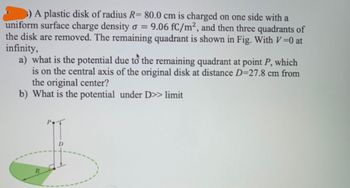Question

Transcribed Image Text:=
5) A plastic disk of radius R= 80.0 cm is charged on one side with a
uniform surface charge density o 9.06 fC/m², and then three quadrants of
the disk are removed. The remaining quadrant is shown in Fig. With V=0 at
infinity,
a) what is the potential due to the remaining quadrant at point P, which
is on the central axis of the original disk at distance D=27.8 cm from
the original center?
b) What is the potential under D>> limit
R
Expert Solution
This question has been solved!
Explore an expertly crafted, step-by-step solution for a thorough understanding of key concepts.
Step by stepSolved in 3 steps with 3 images

Knowledge Booster
Similar questions
- For a point charge, the equipotential surfaces form concentric spheres with the charges at the center. 2 such equipotential surfaces have potentials 293.3V and 95.2V. if these 2 concentric surfaces are separated by a distance of 2.2m, what is the charge of the point particle?arrow_forward= Two charged point-like objects are located on the x-axis. The point-like object with charge 9₁ 92 = -2.20 μC is located at X2 = -1.80 cm. (a) Determine the total electric potential (in V) at the origin. V (b) Determine the total electric potential (in V) at the point with coordinates (0, 1.50 cm). V 5.10 μC is located at X₁ = 1.25 cm and the point-like object with chargearrow_forwardA line of charge of linear density 2=4.5 nC/m lies on the x-axis and extends from x=-5.0 cm to x = 5.0 cm. Find, %3D A) The electric field on the x-axis at -5.5 cm. B) The electric potential at the point (-5.0, +5.0) cm on the x-y coordinate system.arrow_forward
arrow_back_ios
arrow_forward_ios